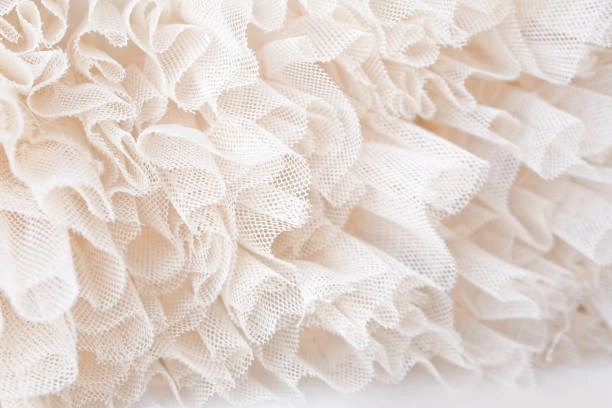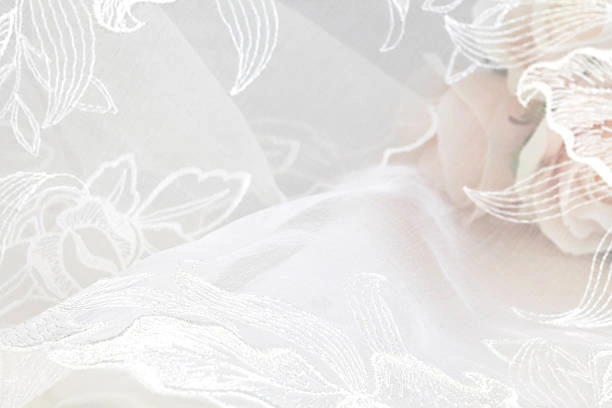With its intricate patterns and delicate texture, lace adds a touch of elegance to any garment or home decor. However, caring for lace, especially removing wrinkles, can be daunting. We understand your concern – who wants to risk damaging such a beautiful, and often expensive, fabric? But don’t worry! Ironing lace doesn’t have to be all or nothing.
With the right technique and a little patience, you can keep your lace looking stunning, smooth, and shiny. In this guide, we’ll walk you through the necessary steps and practical tips to ensure your lace always looks as beautiful as the day you received it, dispelling common myths and providing practical advice for all lace types.
Why Ironing Lace Fabric Requires Special Attention

Before we dive into the “how-to,” let’s quickly understand why ironing lace fabric isn’t quite like pressing a cotton t-shirt. Lace is typically made from delicate fibers like cotton, silk, rayon, or synthetic blends, often featuring openwork patterns that are susceptible to snagging and stretching. High heat and direct pressure can easily scorch, melt, or distort these delicate threads, leading to irreversible damage. Therefore, a gentle, indirect, and low-heat approach is paramount to preserving the integrity and beauty of your lace.
Preparing Your Workspace: The Foundation for Flawless Ironing

A well-prepared workspace is crucial for successful and safe ironing, especially when dealing with something as delicate as lace. Here’s what we’ll need to gather:
- Ironing Board: A sturdy, well-padded ironing board provides a stable surface.
- Clean Iron: Ensure your iron’s soleplate is clean and free of any residue that could transfer to the lace. Distilled water is recommended for the steam function to prevent mineral buildup.
- Pressing Cloth: This is our secret weapon! A clean, white, thin cotton cloth (like an old pillowcase or handkerchief) will act as a barrier between the iron and the lace, protecting it from direct heat and potential scorching.
- Spray Bottle (Optional): For stubborn wrinkles or particularly dry lace, a fine mist of distilled water can help.
- Towels (Optional): For extra padding or for air-drying certain lace types.
- Garment Steamer (Alternative): While not strictly for “ironing,” a steamer can be an excellent, less risky alternative for removing wrinkles from delicate lace.
How to Iron Lace Fabric

Now, let’s get down to the practical steps for achieving wrinkle-free lace. Remember, patience and a gentle touch are key.
Step 1: Check the Fabric Care Label (Our First Priority!)
This is the most critical step before we even plug in the iron. The care label on your lace garment or item will provide specific instructions regarding washing, drying, and ironing temperatures.
Table: Understanding Common Lace Fabric Compositions & Ironing Recommendations
| Fabric Type | Ironing Temperature | Special Considerations |
|---|---|---|
| Cotton Lace | Low to Medium | Can withstand slightly higher heat than synthetics; use steam. |
| Silk Lace | Very Low | Iron on the wrong side; use a pressing cloth; no steam if possible. |
| Rayon Lace | Low | Iron on the wrong side; prone to shrinking with high heat/steam. |
| Synthetic Lace | Very Low (Cool) | Highly susceptible to melting; always use a pressing cloth. |
| Blended Lace | Refer to label | Always err on the side of caution with the lowest recommended heat. |
If there’s no label, assume the most delicate setting (very low heat) and proceed with extreme caution.
Step 2: Prepare the Lace
Before ironing, ensure your lace fabric is clean and dry. Any stains or debris could become set by the heat. If the lace is damp (e.g., air-drying after washing), it can sometimes be easier to iron, but avoid anything more than slightly damp.
Step 3: Set Your Iron to the Correct Temperature
Based on the care label or our fabric type table, set your iron to the lowest appropriate temperature. For most delicate lace (especially synthetics or silk), this will be the “cool” or “silk” setting. Let the iron heat up fully.
Step 4: Position the Lace and Pressing Cloth
Lay the lace fabric flat on your ironing board. For most lace types, especially those with raised patterns, it’s advisable to iron on the wrong side of the fabric. This helps to preserve the texture and prevent flattening the delicate design.
Place your clean pressing cloth over the area of the lace you intend to iron. The pressing cloth acts as a vital barrier.
Step 5: Iron with Gentle, Lifting Motions
This is where the technique comes in. Instead of dragging the iron across the fabric as you might with sturdier materials, use gentle, lifting, and pressing motions.
- Press, don’t drag: Lightly press the iron down onto the pressing cloth for a few seconds, then lift it completely before moving to the next section. This prevents stretching or distorting the lace.
- Avoid prolonged heat: Don’t leave the iron in one spot for too long, even with the pressing cloth.
- Use steam sparingly (if at all): For synthetic or silk lace, avoid steam unless absolutely necessary and test on an inconspicuous area first. For cotton lace, a little steam can help with stubborn wrinkles, but ensure it’s not excessive. If your iron has a steam burst function, use it judiciously.
- Work in small sections: Tackle wrinkles in manageable areas rather than trying to iron the entire piece at once.
Step 6: Check Your Progress and Repeat if Necessary
Carefully lift the pressing cloth and check the lace for wrinkles. If wrinkles persist, reposition the pressing cloth and repeat the gentle pressing motion. It’s better to go over an area multiple times with low heat than to use too much heat once.
Step 7: Allow the Lace to Cool Completely
Once you’ve finished ironing, allow the lace to cool down completely on a flat surface before handling or folding it. This helps to set the shape and prevent new wrinkles from forming.
Troubleshooting Common Lace Ironing Challenges
Even with the best intentions, we might encounter a few hurdles. Here’s how to address them:
- Stubborn Wrinkles: If wrinkles aren’t coming out with low heat and a pressing cloth, try a very light mist of distilled water on the lace before placing the pressing cloth, then iron again. Alternatively, consider using a garment steamer.
- Lace Sticking to the Iron: This is a clear sign the iron is too hot or you’re not using a pressing cloth. Immediately turn off the iron, let it cool, and adjust your settings. Clean the soleplate if necessary.
- Lace Looks Flattened: You’ve likely applied too much pressure or too much heat. This is why ironing on the wrong side and using lifting motions are so important. Unfortunately, severe flattening can be difficult to reverse.
- Snags or Tears: Handle lace gently before, during, and after ironing. If a snag occurs, resist pulling it further. Delicate repair might be possible with a needle and thread, but prevention is always best.
Alternatives to Traditional Ironing for Lace Fabric
Sometimes, the best way to “iron” lace is not to iron it at all! Consider these alternatives for delicate pieces:
1. Garment Steamer
A garment steamer is often the safest and most effective way to remove wrinkles from delicate lace without any direct contact.
How to Use a Garment Steamer for Lace:
- Hang the lace: Hang the lace garment or item on a padded hanger.
- Fill and heat: Fill the steamer’s reservoir with distilled water and let it heat up.
- Steam from a distance: Hold the steamer nozzle a few inches away from the lace, moving slowly up and down the fabric. The steam will relax the fibers and release the wrinkles.
- Allow to dry: Let the lace air dry completely before storing or wearing.
2. Damp Towel Method
For minor creases, this method uses moisture without direct heat.
- Dampen a towel: Lightly dampen a clean, white towel.
- Wrap the lace: Gently wrap the wrinkled lace item in the damp towel.
- Press lightly: Apply gentle pressure to the wrapped bundle, or place a few heavy books on top for a short period.
- Air dry: Unwrap the lace and lay it flat or hang it to air dry, smoothing out any remaining creases by hand.
3. Professional Cleaning/Steaming
For antique lace, very delicate pieces, or items of significant value, professional cleaning and steaming might be the wisest choice. Experts have the specialized equipment and knowledge to handle such fabrics safely.
Caring for Your Lace Beyond Ironing

Proper care extends beyond just knowing how to iron lace fabric. Here are some additional tips to keep your lace looking its best:
- Hand Washing is preferred: For most lace, hand washing in cool water with a mild detergent is gentler than machine washing.
- Air Dry Flat or Hung: Avoid machine dryers, which can cause shrinkage, snags, and damage. Lay delicate lace flat on a clean towel or hang it on a padded hanger to air dry.
- Store Properly: Store lace items flat in acid-free tissue paper or on padded hangers to prevent creases and snags. Avoid hanging heavy lace items, as this can cause stretching.
- Avoid Direct Sunlight: Prolonged exposure to direct sunlight can weaken and yellow delicate lace fibers.
Conclusion
Ironing lace fabric, while seemingly intricate, is a skill that we can easily master with the right approach and a healthy dose of patience. By understanding the unique properties of lace fibers, utilizing a protective pressing cloth, and employing gentle, lifting motions, we can confidently remove wrinkles and restore the pristine beauty of our cherished lace pieces. Remember, when in doubt, err on the side of caution with lower heat settings and consider the invaluable aid of a garment steamer. With these tips in our arsenal, we can ensure our delicate lace items continue to add
